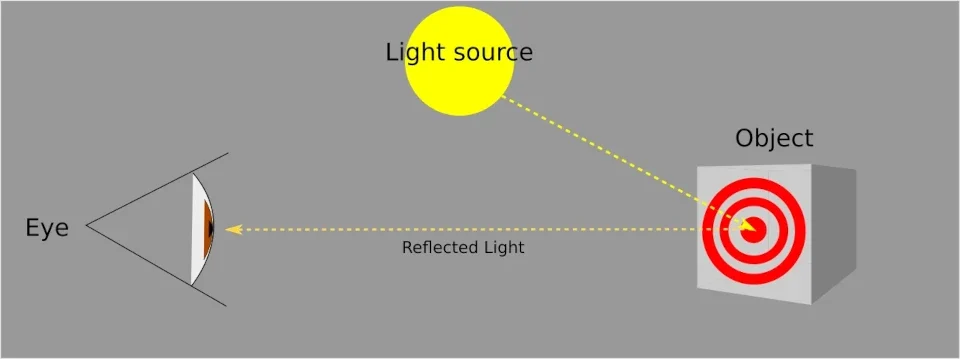Objective Lens
The Objective Lens is lens closest to the target or the lens at the front of the scope furthest from the operators eye.
Considerations when choosing an Objective Lens are:
- Diameter
- Weight
- Lens Optic Quality
- Lens Optical Coatings
- Ambient Light
- Adjustable Objective (AO) Lens
- Exit Pupil

It is all about the light. Light is the reason we see things. Light waves in the visible spectrum reflect off a surface and are transmitted to your eye.

Therefore the amount of light transmitted to the eye determines how well we can see an object.
Diameter
The objective lens diameter is a major factor in determining how much light is delivered to the eye. Most scopes are designed with small to medium objective lens diameters. Fine for most light conditions. For low light conditions it might be desirable to have a larger diameter objective lens.
If the objective lens is large then the objective tube or bell will be large. This can effect the scope clearance from the rifle. This could mean a requirement for non standard (higher) mounting rings, which usually means $$$ dollars.
More importantly, higher mounting rings may take your cheek off a good resting position on the stock. Accuracy can suffer as a result.
A large objective lens also has an effect on our next consideration.
Weight
Adding a scope with a large objective can add a fair bit of weight to your rifle and make it top heavy at that. This can make the rifle awkward and unwieldy. Some scopes come with Adjustable Objective(AO) lenses which tend to compound the problem
Lens Optic Quality
We have established that more light means a brighter image. If the glass the lens is made of has impurities and is poorly finished then the resulting image delivered to the eye will suffer.
Lens Optic Coatings
Optic coatings can mean internal light loss and glare are reduced. Ensure light transmission is uniform, leading to improved image sharpness and contrast. Some coatings are designed to interfere with wavelengths of light, eliminating their reflection.
Overall, coatings try to maximize the light entering the lens and enhance the delivery through to the eye. Coatings can vary from scope to scope and manufacturer.
Ambient Light
Given that light is such an important consideration the ambient light available in the environment you intend to be operating in can be a major factor.
If you are in the open plains of central Australia on a bright Summer day, then your objective lens diameter will not need to be large.
On the other hand, if it is Winter time, close to dusk and you are hunting drop bears in Tasmania’s great South Western forests. Then you will likely need the biggest objective lens you can get your hands on.
Adjustable Objective (AO) Lens
The adjustable objective lens (AO) is a feature that allows the shooter to fine-tune the focus of the reticle or crosshairs. This is especially useful when shooting at long ranges, where small changes in focus can make a big difference in the accuracy of the shot.
Parallax
The adjustable objective lens (AO) is a feature that allows the shooter to fine-tune the focus of the reticle or crosshairs. This is especially useful when shooting at long ranges, where small changes in focus can make a big difference in the accuracy of the shot.
Exit Pupil
The image captured by the objective lens at the shooters eye relief distance from the ocular lens is called the exit pupil.
For my own personal choice for an all round objective lens I lean toward the 40mm. As I am no longer 20, I would opt for a 50mm if it works with the rifle I am using.
Tim
Overall
While we love certain things about certain brands, favor one for their optic quality. Another for extra features you may want or price.
My first scope was a Tasco with a 40mm objective lens bought in 1980, reasonable optics and price and it still does the job nicely today. (Yes, I still have it.)
At the end of the day it depends on what suits your needs in terms of task, environment and price. Do your research and you should achieve a good outcome.
The Objective Lens in Optic Terminology
When you see a rifle scope referred to in language or text it is conventionally given as “4 x 30″ for example.
The “4” refers to how much the target image has been enlarged i.e. an object seems four times closer.
The “30” indicates the objective lens’s diameter in millimeters (mm ).
So a 4 x 30 scope has a 4 times magnification and a 30 mm objective lens.

Ocular Lens
The Ocular Lens is the lens or collection of lenses which is closest to your eye.
Reticles
Reticles, also referred to as crosshairs, are a set of fine lines or markings built into the optics of a scope or telescopic sight for the purpose of aligning the scope and therefore firearm the with the target.
Tube Diameter
Tube diameter of your scope, it can be important! This contains some useful moving parts and its vital that these components have the room to move to suit your needs.

